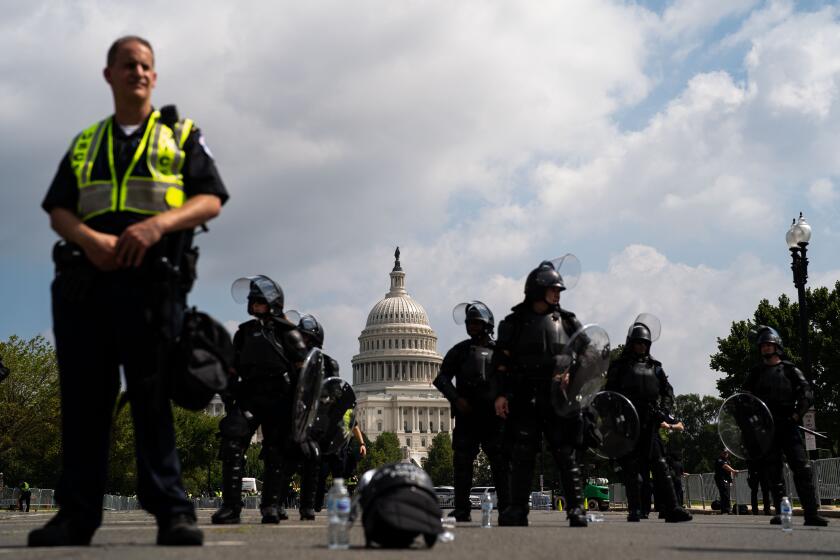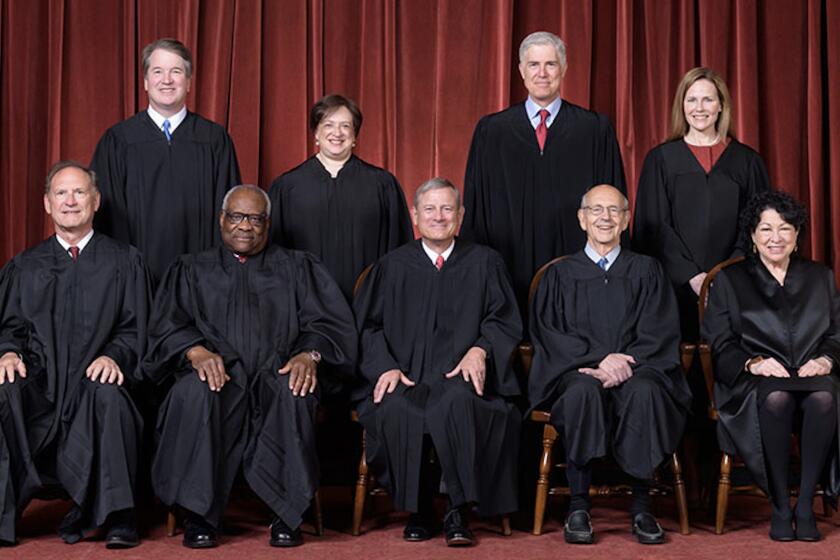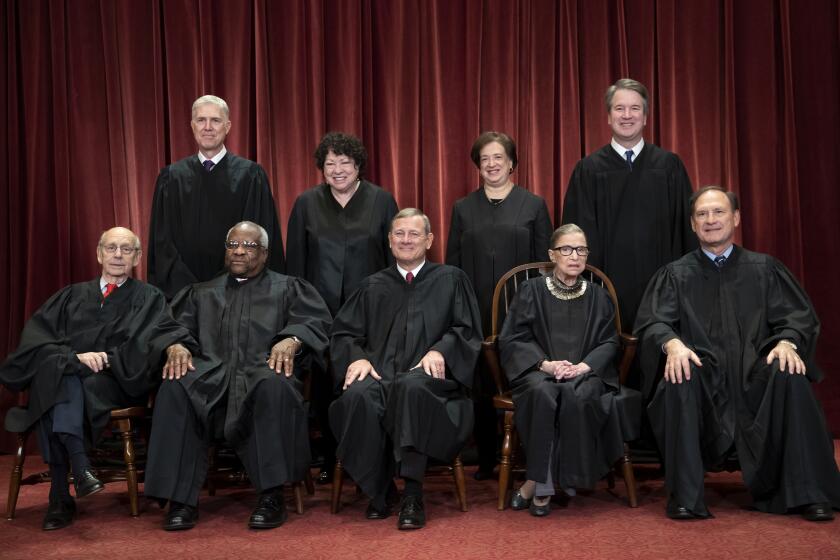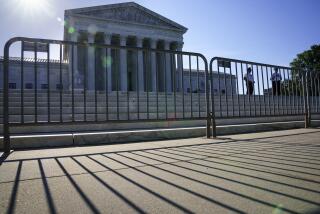Column: How Congress could rein in the rogue Supreme Court

If the Supreme Court’s decisions in 2022 made your skin crawl, what with its eviscerating abortion rights, hobbling gun restrictions and undermining the government’s ability to address global warming, strap yourself in: The 2022-23 session could be as bad, or worse.
So it should come as no surprise that interest in options to clip this Supreme Court’s wings has continued to grow.
On the court’s docket are cases that could limit the federal government’s enforcement of clean water regulations, narrow the Voting Rights Act, outlaw affirmative action policies at universities and protect LGBTQ people from discrimination.
The comforting notion of the court as umpire lies in tatters. It is Justice Samuel Alito’s court now: methodologically flexible but ideologically rigid.
— Law professors Joseph Fishkin and William E. Forbath
The most consequential, and to some observers dangerous, case involves something known as the independent state legislature doctrine.
The argument is that legislatures should be free to regulate congressional elections without regard to their own state constitutions, governors or courts.
Get the latest from Michael Hiltzik
Commentary on economics and more from a Pulitzer Prize winner.
You may occasionally receive promotional content from the Los Angeles Times.
That position could open the door to widespread gerrymandering and even affect the conduct of presidential elections at the state level, posing a new threat to the democratic process.
The court’s rulings on so many closely watched issues in the most recent session have appeared to bring its popularity and public esteem to a historically low ebb, according to opinion polls.
“The comforting notion of the court as umpire lies in tatters,” observed law professors Joseph Fishkin of UCLA and William E. Forbath of the University of Texas in a recent op-ed. “It is Justice Samuel Alito’s court now: methodologically flexible but ideologically rigid.”
Alito was the justice who wrote the notorious decision in Dobbs vs. Jackson Women’s Health Organization, which overturned abortion rights established in 1973 by Roe vs. Wade.
Americans may be unnerved less by the actual outcomes of these cases than by their apparently slipshod and openly partisan reasoning.
Talk of America’s polarization ignores the large majorities that favor abortion rights, COVID restrictions and gun control.
In decades past, Fishkin notes, Anthony M. Kennedy (who sat from 1988 to 2018) and Sandra Day O’Connor (1981-2006) occupied a moderate center. “People had the feeling that a good argument might persuade the court,” he says. “That’s going away. It’s clear that you can predict how Alito will rule by figuring out what the Republican policy is.”
We’ve examined the prevailing ideas for moving the court back to the center, or at least bringing its rulings closer to public sentiment, before. These include expanding its size to provide seats for presumably more liberal jurists or imposing term limits to keep a single bloc from dominating its deliberations for decades, long after the political environment in which they were appointed has withered away.
These ideas have their shortcomings. While the Constitution gives Congress the right to set the court’s size, expansion by one party could lead to a series of tit-for-tat expansions from now to the end of recorded time.
Term limits or similar plans such as age limits could run into constitutional problems. The Constitution says that federal judges “shall hold their Offices during good Behaviour,” which may rule out any other tenure standards.
But as Fishkin and Forbath noted, there are other options that could be more effective and more focused in reining in the court’s partisan instincts. These fall into the general category of “jurisdiction-stripping,” Fishkin told me: Congress forbidding or limiting federal courts’ authority to review its laws.
There’s little doubt that Congress has that right. Most recently, it was exercised in the Inflation Reduction Act, the spending plan signed by President Biden on Aug. 16. The measure bars judicial review of provisions related to drug prices, including how the rule allowing Medicare to negotiate drug prices will be implemented.
The idea of imposing a term limit on Supreme Court justices is gaining traction.
A more instructive example, Fishkin told me, involves the Norris-LaGuardia Act of 1932, which protected the right of workers to unionize and engage in collective bargaining. Among its key provisions was a strict limitation on the authority of federal courts to issue injunctions against unionizing, picketing, striking or assembling peaceably.
This leveled the playing field in labor-management relations that had been tipped sharply toward employers starting with the Pullman Strike of 1894, when President Grover Cleveland’s administration first sought and received court injunctions against the strike to forestall its spread throughout the railroad industry. (Cleveland tried to make amends for his overt favoritism toward the employers by signing the law to establish Labor Day as a national holiday.)
“People often think about ‘jurisdiction’ as whether the courts can hear a certain case at all,” Fishkin says. “But sometimes it’s saying that the courts can’t use certain tools.”
Among other options in this category, Fishkin says, is delaying courts’ authority to rule on certain laws until they have had a chance to work — and presumably gained popularity. Congress could also anticipate the Supreme Court’s objections to a new law by incorporating alternatives to provisions it might overturn that would be perhaps more unpalatable, but unchallengeable.
For example, Congress might have protected the Affordable Care Act’s provisions requiring all states to expand eligibility for low-income residents in Medicaid, which states and the federal government jointly fund, by stating that if the court overturned expansion, then Medicaid would be converted into an all-federal program.
That would have required anticipating Chief Justice John G. Roberts Jr.’s decision upholding most of the act but overturning the mandate for Medicaid expansion and giving states the option of accepting or rejecting it.
The notion of expanding the Supreme Court has been gaining traction lately, thanks in part to the court’s distinct rightward tilt, its increasingly partisan character, and its apparent hostility to abortion rights.
To date, 12 red states still have rejected expansion on ideological grounds, despite incontrovertible evidence that expansion produces cost savings for the states that accept it and leads to healthier residents.
It’s unclear how jurisdiction-stripping might function if Congress codifies abortion rights by law, as Democrats have promised to do if they retain control of both houses; given that states are the source of abortion restrictions in the wake of Dobbs, Congress might wish to leave some authority in the court’s hands to rule on state-level restrictions.
But on gun rights, Fishkin suggests, Congress might carve out a legal zone for states and localities to regulate permitting and carrying rules on a health-and-safety basis, in an effort to circumvent the Supreme Court’s approach to the 2nd Amendment.
What’s best about these options is that they return judgments about the underlying issues to the field of politics, where they belong, rather than judicial action.
Whether the voters will support strong action to limit the Supreme Court’s authority depends, of course, on the court’s level of public esteem.
A common assumption, supported by opinion polls, is that the court’s legitimacy is fading. Whether that trend has reached a crisis stage for the court is still open to question.
In recent months, several justices — notably justices Alito, Roberts, Amy Coney Barrett and Clarence Thomas — have tried to counteract the idea that the court is losing its legitimacy. (Never mind that the doctrinaire conservatism of Barrett, Alito and Thomas is what may be undermining that legitimacy.)
If Democrats take the Senate and the White House, repacking the Supreme Court is imperative.
Other than Roberts, who has tried to map out a more centrist conservative course, none of them has shown a willingness to moderate their positions on the major issues being followed by the public.
That’s a departure from the court’s behavior the last time it was seen as well out of step with public sentiment — in the 1930s, when it delivered a string of decisions overturning New Deal programs and obstructing policies such as the minimum wage.
The court’s rulings, which were rooted in the intransigence of four conservative justices, provoked President Franklin D. Roosevelt to propose a plan in 1936 allowing him to add several new justices to the bench, the so-called court-packing scheme.
Aware that its public standing was at a low ebb, the court reversed itself on the minimum wage, endorsing a Washington state law after having invalidated an almost identical New York statute; after 1936 the court never again overturned a New Deal program. Its about-face was popularly lampooned as “the switch in time that saved nine.”
But dismay about the Supreme Court’s rulings may not exactly correspond to popular eagerness for reforming the institution. There’s a very deep legacy of respect for the court as an institution that may not have been sufficiently shaken, yet.
Many Americans still think of the court as a beacon of progressivism, derived from the Warren Court of the 1950s and ’60s and such decisions as the anti-segregation Brown vs. Board of Education of Topeka (1954), as well as a skein of decisions protecting free speech, the rights of criminal defendants and the separation of church and state. But the Warren years may have been a liberal exception to a long conservative tradition.
“We’re at an early stage” in the evolution of public opinion about the Supreme Court, Fishkin says. “There’s a public conversation that needs to continue for a few years about this thing. Though the court will probably give plenty more reasons for that conversation to continue and escalate.”
More to Read
Inside the business of entertainment
The Wide Shot brings you news, analysis and insights on everything from streaming wars to production — and what it all means for the future.
You may occasionally receive promotional content from the Los Angeles Times.















